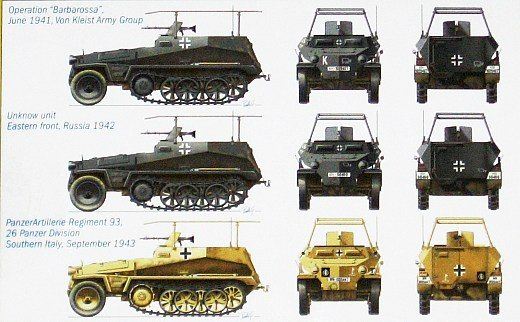The story of the SdKfz 250 segues neatly into the institutional development of the armored force in the second half of the 1930s. On March 15, 1936, a Weapons Office memorandum allocated three missions to the armored force: supporting the infantry attack, providing antitank defense, and carrying out independent operations in cooperation with other motorized troops. But other ideas were also percolating through the military system. The cavalry in particular had been hemorrhaging men and talent. Five of its eighteen regiments had already been transformed into tank, motorized, or motorcycle units. The rest were shedding squadrons for the new antitank and reconnaissance battalions. The Wehrmacht had plans to retain horse cavalry on mobilization, but it would take the field assigned by squadrons to infantry divisions. Small wonder that increasing numbers of talented and/or ambitious junior officers were seeking their future in the mechanized units.
The cavalry had been the army’s social elite since the days of the Great Elector. Even in the Reichswehr years its officer corps included a high proportion of landed gentry: vons and von und zus. Its continuing influence had been highlighted by Maximilian von Weichs’s seamless move into command of the Wehrmacht’s first and only armored division. To respond to the march of progress was one thing; to fade ignominiously away was quite another.
Military considerations shaped the cavalry’s behavior as well. German strategy was, as noted above, still predicated on the defensive. In that context there seemed to be a valuable operational role for a modern force able to perform a screening function, initially engaging and channeling an enemy while the panzer divisions lurked in reserve as a final argument. And should, as expected, the national strategy eventually require a military offensive, then mechanized reconnaissance, screening, and pursuit would be even more necessary. The argument was sufficiently persuasive that in August 1937 the Army Command informed Lutz that instead of creating additional panzer divisions, it planned to create the first of three “light divisions” in the fall of 1937.
The short lives and undistinguished careers of these formations has somewhat obscured their intended character. Though used as such in the Polish campaign, they were not panzer divisions manqué. Nor, as is sometimes asserted, were they a direct response to the French army’s new light mechanized divisions. Their closest analogs are the armored cavalry regiments introduced in the US army’s order of battle during the Cold War era to provide mobility, firepower, and shock action at the operational-level cutting edge. The missions were strikingly similar: reconnaissance and screening, plugging gaps in the line, conducting delaying actions, quickly occupying vital sectors, and, finally, pursuit and overtaking of retreating enemy forces.
The light division’s norm was three “cavalry rifle battalions” and a “cavalry motorcycle battalion,” one or two reconnaissance battalions built around motorcycles and armored cars, and a three-company light tank battalion eventually to be equipped with the later, fast models of the Panzer II. Internal signs of the division’s mission were the transporter vehicles issued to the tank battalion to facilitate operational mobility and save wear on the tanks. The number of machine guns in the rifle battalions was about double that of standard infantry—a useful tactical force multiplier in either defense or attack. Externally, no one could mistake the light divisions’ retention of the cavalry’s yellow branch color as opposed to the pink of the panzer divisions. Nor could anyone mistake the creation of a separate corps command to supervise their training and development.
At the other end of the spectrum, the infantry was also brought under the mobile-warfare tent. It was increasingly clear that mechanization as such was having to compete with a broad spectrum of other rearmament initiatives, in the context of a regime that considered “prioritization” something of a swear word. The three authorized panzer divisions risked being submerged in a growing sea of foot- marching, horse-powered infantry—the exact kind of mass army the Reichswehr’s institutional mentality was conditioned to avoid.
On January 30, 1936, Beck recommended motorizing four infantry divisions. It was quick, it was cheap, and it was doable in the contexts of industrial production and manpower procurement. Beck described motorized divisions as necessary for rapid- approach marches and surprise movements, to provide mobile reserves for the high command, and as a counter to aerial interdiction of rail transport. Significant as well was the French army’s 1935 decision to motorize no fewer than seven of its first-line divisions. Armies resemble the fashion industry in their susceptibility to trends, and health aficionados in their quest for symmetry.
The Lutz/Guderian pressure persisted, and the heritage of fifteen years’ worth of theoretical consideration on the prospects of large-scale mobile war remained active. In May the General Staff described motorized divisions as having the same capacity as their standard counterparts, but with an added capacity for rapid movement and maneuver. Suitable as mobile reserves, presumably for defensive purposes, motorized divisions could also be concentrated in mobile armies, presumably for offensives at the operational level in combination with the light and panzer divisions.
Like the light divisions, the new motorized divisions received their own corps headquarters. They also kept their original branch color: white. Otherwise, they were not exactly given a lot of thought. Four standard infantry divisions simply turned in their horses for trucks, motorcycles, and a dozen armored cars. They did have one tactical advantage over their French counterparts. For mobility, the French division’s infantry depended heavily on a Groupement of trucks attached for each move. The German trucks were organic down to company/platoon level—a major difference in flexibility even if the trucks were essentially road-bound and highly vulnerable even to small-arms fire.
